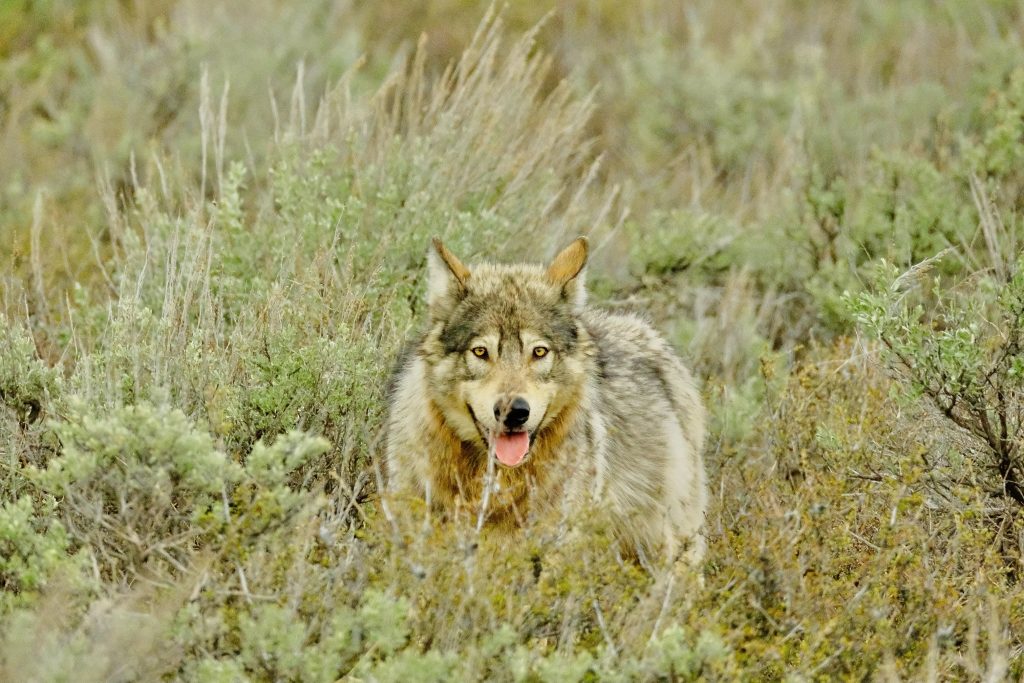Idahoans come to Carbondale with stories of successful wolf coexistence

River Stingray/The Aspen Times
Three Idahoans with deep histories in ranching, wolf restoration, and predator control came to Carbondale last week to discuss the ways that coexisting with wolves could be possible in the Roaring Fork Valley for ranchers and community members.
Wolves have been present in Colorado since December 2023, when Colorado Parks and Wildlife released 10 animals in Grand and Summit counties after voters approved wolf reintroduction in 2020. The next wolf release is scheduled for January 2026.
While persisting conflicts in Pitkin County with wolf depredation of livestock has created doubts that both wolves and humans can thrive on the same landscape, Alderspring Ranch CEO and Co-Founder Glenn Elzinga has successfully gone a decade with no livestock losses to wolves despite living with them in the central Idaho Rocky Mountains.
“They would howl all night,” Elzinga said of wolves around their grazing sites. “We’d be down there … (but have) no interaction. If we maintain that human presence, we won’t have predation. It’s all about human presence.”
He said he started Alderspring Ranch in 1993 with seven cows and 60 acres. He had no idea that the land would be located in “the wolf hotbed in central Idaho” after reintroduction began.
“We were grazing right next to them,” he said of wolves who moved into the area.
Elzinga noted that he saw incremental calf losses up until 2012, when the wolf population peaked in Idaho at around 2,000 wolves. He lost about 10% of his calf crop that year, which he noted was about $90,000 worth of cattle, or $250,000 to $300,000 worth in today’s economy.
“We were going to turn out the following year, but then we lost a few more that crescendoed the cash loss,” he said, noting that a den of wolves made their home in his main grazing area.
That could have been the end for him and his business, but he returned the following year and hasn’t had a single wolf depredation since.
Sunrise Rundown: Headlines. Breaking News. Local Updates.
What’s happening in Aspen, in one click.
Sign up for the Sunrise Rundown at AspenTimes.com/newsletter
“We changed the way we were grazing,” Elzinga said. “We changed the way we thought. The thing we went back to was history.”
Following traditional ways of ranching and cowboy camping, he changed his ranching operations to herding cattle by hand and sleeping with them in cowboy camps at night. While that required more work, he found that the cows gained weight more efficiently. With 500 head of cattle and beef priced at about $3 per pound, he said after 100 days of herding he earned an additional $150,000 on the extra weight. Although it cost about $100,000 to put people on the ground to herd, he still made a profit.
And it isn’t just the ranchers and cows that are benefitting. Herding the cattle to graze them has improved the biodiversity of Elzinga’s land, stirring up the soil and improving the rangeland, in addition to getting cattle out of riparian zones.
“These creeks respond like crazy,” he said. “Fish habitats respond. We don’t purify water any more; we drink right out of the creeks. The other thing we got was beaver response.”
Carter C. Niemeyer, who worked in predator management for the government for 33 years before retiring from the U.S. Fish and Wildlife Service in 2006, was part of the efforts that federally reintroduced wolves into Idaho near Elzinga’s ranch. A hunter and trapper since he was 9 years old, Niemeyer noted he’s personally caught 300 wolves and killed 13 during his tenure in predator control.
Even with all the conflict he’s witnessed between humans and wolves, he assured Colorado there’s a way to make it work.
“There is a way to reach sustainable populations of wolves and not eliminate the cattle or the sheep industry,” he said. “We learned a lot of hard lessons, and the wolves are the ones who paid the price … (but now) it’s possible with the right attitude.”
Suzanne Asha Stone, founder and executive director of the International Wildlife Coexistence Network who was a member of the 1990s Yellowstone/Idaho wolf reintroduction team, echoed this sentiment.
“You can have wolves, you can have livestock,” Stone said. “You can make this work. It’s really about the attitude.”
She has run the Wood River Wolf Project in Blaine County, Idaho, for the past 18 years, using nonlethal efforts to keep 22,000 sheep grazing in the 1,200 square kilometer project area, with fewer than five sheep on average lost to wolves annually. In those 18 years, only two wolves have been killed due to livestock conflicts.
“We’ve had wolves back in Idaho since the mid-1990s, and we’ve made a lot of the mistakes for you,” she said at the conference. “We started with a trainwreck in 2007. There were calls for killing the whole pack of wolves. But we don’t accept that this is a win-lose. We want a win-win.”
Blaine County adopted nonlethal deterrents despite skepticism from researchers and academics.
“This had never been done before … across a very large landscape,” Stone said. “They said we can’t do it, but nobody had tried it.”
Fladry has been a huge tool for Blaine County, putting sheep in pens at night surrounded by flags on ropes whose movement deters wolves from crossing them. This was a technique initially used in Poland to funnel wolves for hunting.
“We had the most rugged country, we had the most vulnerable livestock — it was all working against us,” Stone said of implementing this nonlethal method, “and we had no more losses.”
Blaine County has also been utilizing fox lights out in the field around where sheep are bedding at night to make it look like someone is active and walking around with a flashlight.
“This is our pathway forward,” she said. “The guys next door (in neighboring counties) were losing 10 times the amount of sheep. Despite killing entire packs, they were losing a lot more livestock. You’ve just got to know which tool to use on the ground and when, and it works.”
Elzinga remembered an anecdote from the first time he witnessed a wolf up close, approaching her in a cage prior to a release.
“She looked right at me, and I looked right at her, and I said, ‘Are you going to change my life forever?’ And she said, ‘Of course I am.’ And she did,” he said, “she changed our minds.”
Preps: Aspen volleyball rallies to win regional, will play in state tournament
Trailing early in the regional final on Saturday, Aspen volleyball rallied to beat Vanguard in five sets inside the AHS gymnasium, punching the Skiers’ ticket to the Class 3A state tournament in Denver.
Colorado ski industry worried about slowdown in J-1 visas that are ‘essential’ for resort area workforce
Ski areas in Colorado and across the country are concerned about reported processing slowdowns for seasonal worker visas ahead of the 2025-26 ski season, according to the industry’s leading trade group.








